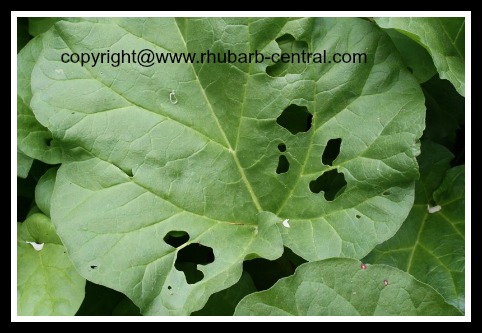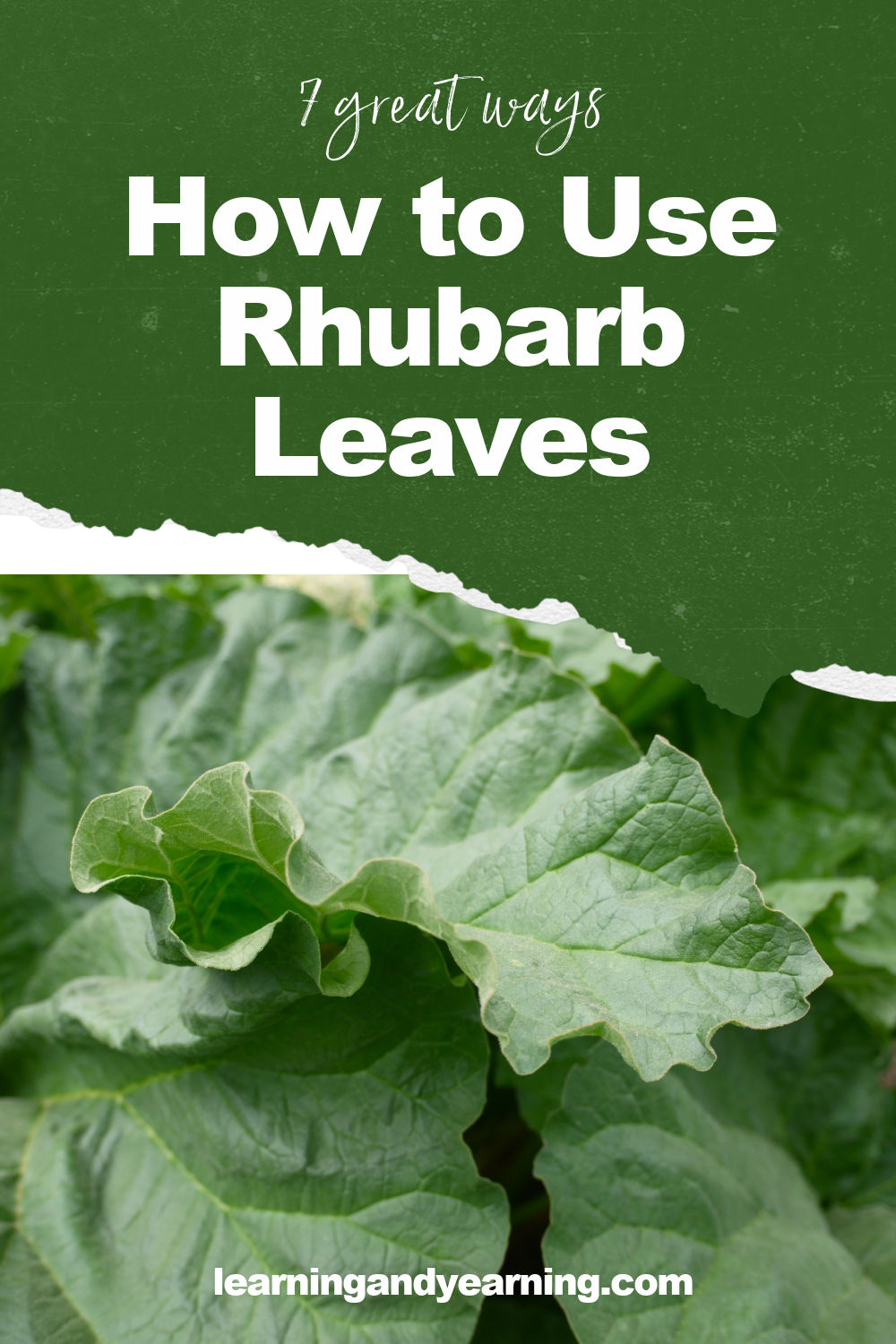To keep bugs from eating rhubarb leaves, apply organic insecticides or pest control methods. Rhubarb is susceptible to various pests, such as aphids and beetles, which can damage the leaves and hinder plant growth.
An effective way to combat these pests is by using natural options like neem oil or insecticidal soap. Additionally, regularly inspect the plants for any signs of infestation, and manually remove any bugs present. Promoting a healthy growing environment by providing adequate sunlight, proper watering, and good air circulation can also help prevent bugs from being attracted to the rhubarb plants.

Credit: www.rhubarb-central.com
How to Keep Bugs from Eating Rhubarb Leaves: 8 Easy Steps
1. Identify The Common Garden Pests That Attack Rhubarb Leaves
Bugs can be a nuisance when it comes to protecting your rhubarb plants from leaf-eating pests. Identifying the common garden pests that attack rhubarb leaves is crucial in preventing damage. There are different types of bugs that may eat rhubarb leaves, such as aphids, beetles, and caterpillars.
These pests can cause significant harm to the plants if left uncontrolled. To determine if your rhubarb plants are infested with bugs, keep an eye out for signs like holes or chewed edges on the leaves. Inspecting the undersides of the leaves can also reveal the presence of pests.
Taking preventive measures like regular inspection, using organic insecticides, and practicing good garden hygiene can help keep bugs away and ensure the health and productivity of your rhubarb plants.
2. Implement Physical Barriers To Protect Rhubarb Leaves
Rhubarb plants are often plagued by bugs that feast on their leaves, leading to significant damage. One way to protect your rhubarb leaves is to implement physical barriers. This can be done by using floating row covers, which act as a shield for the plants.
These covers are lightweight and can be placed directly over the rhubarb, creating a barrier that insects cannot penetrate. Another option is to build a simple fence or cage around the plants, preventing bugs from reaching the leaves. By taking these steps, you can effectively keep bugs from eating your rhubarb leaves and ensure a healthy harvest.
3. Incorporate Companion Planting To Deter Bugs
Keeping bugs from eating rhubarb leaves is a common concern for gardeners. One effective method is incorporating companion planting, which involves selecting bug-repellent plants to grow alongside rhubarb. By creating a diverse ecosystem, pests are discouraged from infesting the plants.
You can choose plants that naturally repel bugs, such as marigolds or garlic. These plants emit strong odors that deter insects. Additionally, flowers like nasturtiums not only repel pests but also attract beneficial insects that prey on bugs. Another option is planting herbs like basil or rosemary, which bugs tend to avoid.
By strategically choosing companion plants, you can create a natural defense against bugs and ensure healthy growth for your rhubarb.
4. Utilize Organic Pest Control Methods
One effective way to keep bugs from devouring your rhubarb leaves is to utilize organic pest control methods. An easy homemade insecticidal soap spray can effectively deter pests from infesting your plants. Another strategy is to encourage beneficial insects that prey on rhubarb pests, such as ladybugs and lacewings.
These insects can help keep the bug population in check. Additionally, neem oil can serve as a natural bug repellent for your rhubarb plants. Its strong odor repels many common pests while being safe for beneficial insects and the environment.
By implementing these organic pest control methods, you can protect your rhubarb leaves from being eaten by bugs and promote a healthy and thriving garden.
5. Proper Garden Hygiene And Maintenance
To keep bugs from eating the leaves of your rhubarb plants, regular garden hygiene and maintenance are essential. Make sure to frequently remove fallen leaves and debris from around the rhubarb plants. This will help prevent insects from finding shelter and breeding grounds.
Bugs are attracted to decaying organic matter, so by keeping your garden clean, you can minimize their presence. Additionally, be sure to regularly inspect your plants for any signs of bug infestation and promptly address any issues you find. Regularly watering your rhubarb plants and providing them with proper nutrition will also help them stay healthy and more resistant to pests.
By implementing these practices, you can maintain bug-free rhubarb leaves and ensure a successful harvest.
6. Time Your Planting And Harvesting For Bug Control
To keep bugs from eating rhubarb leaves, it’s crucial to time your planting and harvesting correctly. Planting your rhubarb when bug activity is low can discourage infestations. By doing this, you reduce the chances of bugs damaging the leaves. Additionally, harvesting the rhubarb leaves before bugs become more active can help protect your plants.
This ensures that bugs don’t have the opportunity to devour the leaves and potentially harm the overall growth of your rhubarb. It’s essential to be mindful of bug control measures in order to maintain a healthy rhubarb garden. So, carefully consider the timing of your planting and harvesting to keep those pesky bugs at bay.
7. Observe And Monitor Rhubarb Plants For Early Pest Detection
Inspect your rhubarb leaves regularly for signs of bug damage, as early detection is essential. Look for chewed edges, holes, or discoloration on the leaves. If you spot any of these signs, take immediate action to implement control measures. This might include using organic insecticides or introducing beneficial insects to your garden.
By staying vigilant and regularly checking your rhubarb plants, you can prevent bugs from devouring your leaves and damaging the overall health of the plant. Remember that early intervention is key to keeping your rhubarb healthy and thriving. Don’t wait until the infestation worsens; act at the first sign of pests to protect your precious rhubarb crop.
8. Additional Tips And Precautions
To keep bugs from feasting on rhubarb leaves, there are additional tips and precautions you can take. First, use organic fertilizers to maintain the plant’s health and resilience. These fertilizers are less likely to attract pests. Another effective method is practicing crop rotation.
By alternating the location of your rhubarb plants each year, you discourage the buildup of bug populations. However, if you face severe pest infestations, it’s best to seek professional advice. Professionals can offer targeted strategies and recommend safe and effective insecticides.
Remember, prevention is key when it comes to protecting your rhubarb from hungry bugs. Implement these tips and precautions to enjoy healthy, thriving rhubarb plants throughout the growing season.
Frequently Asked Questions On How To Keep Bugs From Eating Rhubarb Leaves
How Do You Make Bug Spray For Rhubarb?
To make bug spray for rhubarb, mix water, dish soap, and neem oil in a spray bottle.
How Do You Get Rid Of Holes In Rhubarb Leaves?
To get rid of holes in rhubarb leaves, remove any damaged leaves, apply organic insecticide, and regularly monitor for pests.
Can You Make A Bug Spray With Rhubarb Leaves?
Yes, you can make a bug spray using rhubarb leaves.
Why Are There Holes In My Rhubarb Leaves?
Holes in rhubarb leaves are likely caused by pests, such as insects or slugs.
Conclusion
Protecting your rhubarb leaves from pesky bugs is essential to ensuring a bountiful harvest. By implementing the strategies discussed such as companion planting, regular monitoring, and natural pest repellents, you can create a pest-resistant environment for your rhubarb plants.
Remember to remove any affected leaves promptly and maintain proper garden hygiene to prevent the spread of pests. Applying organic insecticides when necessary can also provide an extra layer of defense. Furthermore, considering the importance of pollinators, it is critical to adopt eco-friendly practices that do not harm beneficial insects.
With proper care and attention, you can enjoy healthy rhubarb plants without worrying about bugs devouring those beautiful leaves. Happy gardening!

